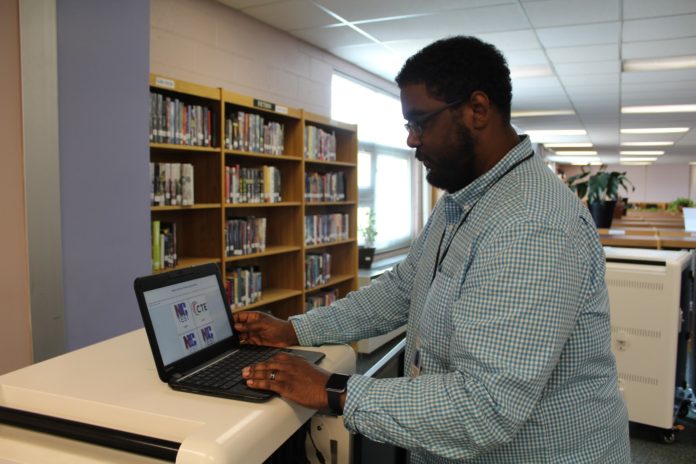
Each middle- and high-school student in Chapel Hill-Carrboro City Schools (CHCCS) will receive a personal computer for take-home educational use starting next year, the district announced, through a new program intended to improve education by increasing technology access.
In the 1:1 program—pairing students to devices “one to one”—the district will distribute Google Chromebook laptops from existing supplies and will purchase more of the cost-effective $150 devices, Kenneth Kingsberry, Chapel Hill High School’s instructional technology facilitator, said.
In recent years, nearby districts like Orange County Schools and many around the world have rolled out 1:1 computing programs. CHCCS announced June 7 it will follow suit.
“Chapel Hill-Carrboro City Schools is committed to empowering, inspiring and engaging all students,” Debby Atwater, the district director for digital learning and libraries, wrote in the email. “Our secondary students need reliable access to instructional resources and opportunities during and after the school day to meet the current demands of education.”
The Computer Check-Out Program, in middle and high schools, currently lets district families borrow devices. Kingsberry said that this year he almost ran out of MiFi routers—basically mobile Wi-Fi hotspots—and Chromebooks to lend.
The 1:1 program next year will alleviate the access problem, and the district is working on how students without internet at home now will be able to use their Chromebooks by budgeting for additional MiFi routers and talking with Carrboro about expanding the town’s free Wi-Fi coverage.
Students in the district high schools will pick up their computers at Carrboro High School during the week of August 12, the district said, or in the first week of the 2019–20 school year. The middle schools will distribute Chromebooks to their students after the start of the year, and anyone who transfers in will be able to check one out, Kingsberry said.
Across the country and world, the recent growth of educational technology use has led to greater screen time and proficiency for students, according to the preview of a forthcoming review of education technology by the Abdul Latif Jameel Poverty Action Lab (J-PAL). Chromebooks have dominated American schools including CHCCS, which has given Google accounts to students since 2014, Atwater said.
CHCCS fits the broader trend of increasing computer access, as well. In 2008, it had 2.52 students per device, as measured by the North Carolina district report card, though, a decade later, the statistic had fallen to 0.88. (The state average last year was 0.96 students per device.)
Though the 1:1 plan will let students use the internet for assignments, research or applications, it is not without challenges. The estimated additional cost to implement 1:1 is about $508,000 for six years, district representatives recently told the school board, so that it can refresh expiring Chromebooks with new ones that have touchscreens and accidental damage protection, Atwater said.
The district will continue to impose content restrictions on school Google accounts on the laptops through Zscaler, a tech security company, which Kingsberry said lets the district intervene when needed, like in cases of self-harm. “There’s always a balancing act between privacy or infringement and actually being able to help,” he said.
Some students are already required to spend lots of time on screens in school: junior Emmanuel Eggleton, who transferred from Wake Forest High School this semester, took four online courses through North Carolina Virtual Public School (NCVPS), totalling more than 16 hours a week.
“It was excruciating,” Eggleton said, recalling that he learned all the required material but missed having a face-to-face teacher and struggled at times with procrastination. “I guess that was because of myself. I wouldn’t say that I’m the teacher, but I have to depend on myself to turn things in.”
Chapel Hill’s online learning facilitator, Daniel Reinholz, said that because the district has to pay for each NCVPS class—this year, CHCCS spent about $288,000 for 746 course instances—student interest can figure into hiring a new teacher; at Chapel Hill, 111 students took AP Psychology online this year, so, he said, it will be offered in-person next year.
“In my opinion and, I think, a lot of instructors’, online is a good backup, but for many students the data support actual in-class instruction as being better for many students and their learning styles,” Reinholz said.
The J-PAL researchers reached similar conclusions. While technologies like individually tailored “computer-assisted learning” were found to help teach particular information to students, classes taught completely online were in general worse for achievement than traditional ones.
The 1:1 plan will make online education more accessible, and, Kingsberry said, students will be expected to bring their Chromebooks, with enough battery life, to classes and standardized tests.
The district does not expect that every computer will use Chrome OS. There is no plan to change teachers’ devices, though “it would be nice if we all were in that same ecosystem to show that there’s no difference,” Kingsberry said. Some products widely used in schools, like Smart Board, are not fully compatible with Chromebooks. And career and technical education and other courses can still have their own devices for specialized software.
Chromebooks, through 1:1, are nonetheless a major part of the district’s future.
“Management and in-user experience are much better on these devices than on Windows and, in my preference, even Macbooks,” Kingsberry said. “If you have a $1,000 machine, cut it on and go straight to Google [products], why do you need a Macbook?”











